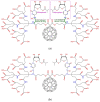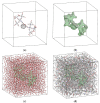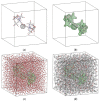Fullerene Derivatives for Drug Delivery against COVID-19: A Molecular Dynamics Investigation of Dendro[60]fullerene as Nanocarrier of Molnupiravir
- PMID: 35957142
- PMCID: PMC9370322
- DOI: 10.3390/nano12152711
Fullerene Derivatives for Drug Delivery against COVID-19: A Molecular Dynamics Investigation of Dendro[60]fullerene as Nanocarrier of Molnupiravir
Abstract
In this paper, a theoretical investigation is made regarding the possibility of using a water-soluble derivative of C60 as a drug delivery agent for treating Coronavirus disease 2019 (COVID-19). Molnupiravir is chosen as the transporting pharmaceutical compound since it has already proved to be very helpful in saving lives in case of hospitalization. According to the proposed formulation, a carboxyfullerene known as dendro[60]fullerene is externally connected with two molnupiravir molecules. Two properly formed nitrogen single bonds (N-N) are used as linkers between the dendro[60]fullerene and the two molnupiravir molecules to create the final form of the C60 derivate/molnupiravir conjugate. The energetics of the developed molecular system and its interaction with water and n-octanol are extensively studied via classical molecular dynamics (MD) using the COMPASS II force field. To study the interactions with water and n-octanol, an appropriate periodic amorphous unit cell is created that contains a single C60 derivative/molnupiravir system surrounded by numerous solvent molecules and simulated via MD in room conditions. In addition, the corresponding solvation-free energies of the investigated drug delivery system are computed and set in contrast with the corresponding properties of the water-soluble dendro[60]fullerene, to test its solubility capabilities.
Keywords: COVID-19; drug delivery; fullerene; molecular dynamics; molnupiravir; solvation free energy.
Conflict of interest statement
The author declares no conflict of interest.
Figures











Similar articles
-
Anticoronavirus Activity of Water-Soluble Pristine C60 Fullerenes: In Vitro and In Silico Screenings.Adv Exp Med Biol. 2021;1352:159-172. doi: 10.1007/978-3-030-85109-5_10. Adv Exp Med Biol. 2021. PMID: 35132600
-
Adsorption of Molnupiravir anti-COVID-19 drug over B12N12 and Al12N12 nanocarriers: a DFT study.J Biomol Struct Dyn. 2023;41(22):12923-12937. doi: 10.1080/07391102.2023.2169763. Epub 2023 Jan 23. J Biomol Struct Dyn. 2023. PMID: 36688358
-
Biological evaluation and molecular dynamics simulation of water-soluble fullerene derivative C60[C(COOH)2]3.Toxicol In Vitro. 2020 Feb;62:104683. doi: 10.1016/j.tiv.2019.104683. Epub 2019 Oct 19. Toxicol In Vitro. 2020. PMID: 31639450
-
Synthesis and biological application of glyco- and peptide derivatives of fullerene C60.Eur J Med Chem. 2022 Feb 15;230:114104. doi: 10.1016/j.ejmech.2022.114104. Epub 2022 Jan 10. Eur J Med Chem. 2022. PMID: 35051749 Review.
-
Antiviral activity of molnupiravir against COVID-19: a schematic review of evidences.Bull Natl Res Cent. 2022;46(1):62. doi: 10.1186/s42269-022-00753-9. Epub 2022 Mar 10. Bull Natl Res Cent. 2022. PMID: 35287311 Free PMC article. Review.
Cited by
-
Cytotoxicity of Carbon Nanotubes, Graphene, Fullerenes, and Dots.Nanomaterials (Basel). 2023 Apr 25;13(9):1458. doi: 10.3390/nano13091458. Nanomaterials (Basel). 2023. PMID: 37177003 Free PMC article. Review.
-
Functionalized Fullerene Potentially Inhibits SARS-CoV-2 Infection by Modulating Spike Protein Conformational Changes.Int J Mol Sci. 2023 Sep 23;24(19):14471. doi: 10.3390/ijms241914471. Int J Mol Sci. 2023. PMID: 37833919 Free PMC article.
-
DFT investigation of temozolomide drug delivery by pure and boron doped C24 fullerene-like nanocages.Nanoscale Adv. 2023 Sep 8;5(21):5880-5891. doi: 10.1039/d3na00402c. eCollection 2023 Oct 24. Nanoscale Adv. 2023. PMID: 37881702 Free PMC article.
-
Inorganic nanoparticle-cored dendrimers for biomedical applications: A review.Heliyon. 2024 Apr 16;10(9):e29726. doi: 10.1016/j.heliyon.2024.e29726. eCollection 2024 May 15. Heliyon. 2024. PMID: 38694058 Free PMC article. Review.
-
Smart drug delivery: a DFT study of C24 fullerene and doped analogs for pyrazinamide.Nanoscale Adv. 2024 Dec 17;7(5):1287-1299. doi: 10.1039/d4na00560k. eCollection 2025 Feb 25. Nanoscale Adv. 2024. PMID: 39802333 Free PMC article.
References
LinkOut - more resources
Full Text Sources

